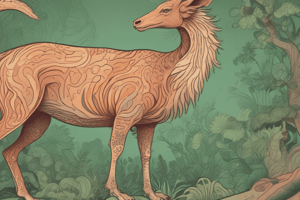Podcast
Questions and Answers
What is the primary function of the epididymis in the male reproductive system?
What is the primary function of the epididymis in the male reproductive system?
- To produce sperm.
- To excrete waste products.
- To propel sperm through the vas deferens.
- To store and mature sperm. (correct)
What is the process called when a mature egg is released from the ovary?
What is the process called when a mature egg is released from the ovary?
- Oogenesis.
- Gametogenesis.
- Menstruation.
- Ovulation. (correct)
What type of neuron transmits information about external stimuli such as light, touch, or smell?
What type of neuron transmits information about external stimuli such as light, touch, or smell?
- Sensory neurons. (correct)
- Motor neurons.
- Interneurons.
- Glial cells.
What is the primary function of the hypothalamus in reproduction?
What is the primary function of the hypothalamus in reproduction?
What is the term for the junction between an axon and another cell?
What is the term for the junction between an axon and another cell?
What is the term for the membrane potential of a neuron that is not sending signals?
What is the term for the membrane potential of a neuron that is not sending signals?
What hormone stimulates the uterus to contract during childbirth?
What hormone stimulates the uterus to contract during childbirth?
What is the process by which gametes are produced from germ cells?
What is the process by which gametes are produced from germ cells?
What is the term for the creation of an offspring by fusion of an egg and sperm?
What is the term for the creation of an offspring by fusion of an egg and sperm?
What is the major source of membrane potential in a neuron?
What is the major source of membrane potential in a neuron?
What type of channels trigger a depolarization in a neuron?
What type of channels trigger a depolarization in a neuron?
What is the term for the clustering of sensory organs at the front end of the body in bilaterally symmetrical animals?
What is the term for the clustering of sensory organs at the front end of the body in bilaterally symmetrical animals?
What is the function of glial cells in the nervous system?
What is the function of glial cells in the nervous system?
What is the term for the ability of the nervous system to be remodeled after birth?
What is the term for the ability of the nervous system to be remodeled after birth?
What is the part of the brain that coordinates movement and balance and helps in learning and remembering motor skills?
What is the part of the brain that coordinates movement and balance and helps in learning and remembering motor skills?
What is the term for a massive change in membrane voltage that results from a sufficient depolarization?
What is the term for a massive change in membrane voltage that results from a sufficient depolarization?
What is the part of the brain that includes the body's thermostat and biological clock?
What is the part of the brain that includes the body's thermostat and biological clock?
What is a nerve composed of?
What is a nerve composed of?
What is the largest structure in the brain that is essential for language, cognition, memory, and consciousness?
What is the largest structure in the brain that is essential for language, cognition, memory, and consciousness?
Flashcards are hidden until you start studying
Study Notes
Animal Reproduction
- Sexual reproduction: creation of offspring by fusion of haploid gametes, with advantages of increased genetic variation and adaptation to changing environments.
- Asexual reproduction: creation of offspring without fusion of egg and sperm, with advantages of rapid reproduction and genetic uniformity, but rare in vertebrates.
- Examples of animals that reproduce sexually: most vertebrates; examples of animals that reproduce asexually: sponges and hydra.
Fertilization
- Internal fertilization: occurs in a dry environment, with fewer gametes produced but higher survival chances.
- External fertilization: occurs in a moist environment, with more gametes produced but lower survival chances.
Reproductive Organs
- Gonad: organs that produce gametes (testes in males, ovaries in females).
- Male reproductive organs: sperm produced in seminiferous tubules, pass through epididymis, vas deferens, and urethra.
- Female reproductive organs: eggs produced in ovaries, travel through oviduct to uterus.
Gametogenesis
- Gametogenesis: production of gametes from germ cells.
- Spermatogenesis: formation of sperm, producing 4 sperm with no interruptions.
- Oogenesis: development of a mature egg, producing 1 egg with a prolonged process that stops at menopause.
Hormones in Reproduction
- Hormones involved in reproduction: GnRH, FSH, LH, testosterone, estrogens (estradiol and progesterone).
- Regulation of ovarian and menstrual cycles by sex hormones.
- Menopause: end of ovarian and menstrual cycles in females.
Neurons and Signaling
Structure of a Neuron
- Cell body: contains most of a neuron's organelles.
- Dendrites: highly branched extensions that receive signals from other neurons.
- Axon: longer extension that transmits signals to other cells at synapses.
- Synapse: junction between an axon and another cell.
Types of Neurons
- Sensory neurons: transmit information about external stimuli.
- Interneurons: integrate and interpret information.
- Motor neurons: transmit signals to muscle cells, causing contraction.
Glial Cells
- Glial cells (Glia): supporting cells that nourish, support, and regulate neurons.
Mechanisms of Signal Transmission
- Resting potential: membrane potential of a neuron not sending signals, with many open K+ channels and fewer open Na+ channels.
- Action potential: changes in membrane potential, signals conducted by axons, resulting in a massive change in membrane voltage.
Nervous Systems
Nerve and CNS
- Nerve: axons of multiple neurons bundled together.
- CNS: central nervous system, consisting of brain and spinal cord.
- PNS: peripheral nervous system, consisting of neurons carrying information in and out of CNS.
Structure of Brain
- Forebrain: includes cerebrum, thalamus, hypothalamus, and amygdala.
- Midbrain
- Hindbrain: includes cerebellum, medulla, and pons.
Cephalization and Neuronal Plasticity
- Cephalization: clustering of sensory organs at the front end of the body in bilaterally symmetrical animals.
- Neuronal plasticity: ability of the nervous system to be remodeled after birth.
Studying That Suits You
Use AI to generate personalized quizzes and flashcards to suit your learning preferences.



